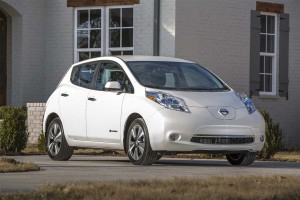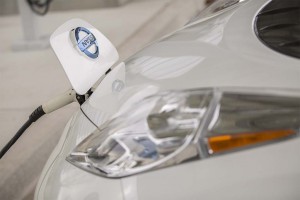Despite recent struggles in the market, battery-electric vehicles are going “mainstream ,” or so says Carlos Ghosn, CEO of the Renault-Nissan Alliance – which just happens to produce the world’s best-selling EV, the Nissan Leaf.
That optimism might not be shared by everyone. With gas prices in a slump – and expected to dip even further – sales of battery-based vehicles have taken a sharp tumble this year. The Leaf itself was down 23% in the U.S. for the first half of 2013. But in a commentary on LinkedIn, Ghosn suggested the setback is temporary.
And he predicted demand will get a boost with the launch of longer-range electric vehicles such as the ones Renault-Nissan plans to introduce later this year.
“From the start, we set lofty goals for the LEAF. While we fell short of our initial sales targets, I remain bullish on the future of EVs as they move into the mainstream,” Ghosn wrote.
(Hybrid, battery-car sales plunge during 1st half of 2015. Click Here for the latest.)
There’s at least one key reason why electrified vehicles will become much more commonplace, the Brazilian-born executive stressed: the global trend towards tougher restrictions on CO2 emissions. That means “all automakers will need to offer zero-emissions alternatives in their fleets.”
But while Ghosn called the EV “the most practical alternative,” the Nissan side of Alliance appears to be hedging its bets a bit. Just last week the company joined with its two largest Japanese rivals, Toyota and Honda, to announce funding for a network of hydrogen pumping stations across Japan. The move is meant to create what has been dubbed a “Hydrogen Society.”
(For more on this hydrogen joint venture, Click Here.)
Nissan also is working to improve the battery charging infrastructure around the world. Just the week, the Japanese maker announced plans to expand its “No Charge to Charge” program to Boston. It gives owners of the Leaf free access to super-fast chargers in a growing number of cities already including San Francisco, Los Angeles, Seattle, Chicago, New York and Houston, with 17 more to follow.
Industry analysts have suggested that automakers like Renault and Nissan have to address at least three key challenges before electric vehicles go mainstream. The “No Charge to Charge” program is one step. Several cuts in the price of the Leaf have begun to address the cost issue. Next, it appears, the Alliance partners are going after the range issue.
“Later this year, you will hear more about our initial steps to increase the range of our EVs,” wrote Ghosn. “Our goal is to eliminate ‘range anxiety’ for our customers, as we continue our effort to make zero-emission vehicle a mainstream choice.”
Currently, the Nissan Leaf has an EPA-rated range per charge of just 84 miles. As TheDetroitBureau.com reported early this year, the goal is to get that up to something closer to 200 miles when the second-generation Leaf is introduced, according to several sources including Nissan design director Shiro Nakamura.
Nissan is by no means the only maker hoping to overcome range anxiety. The longest-range version of the Tesla Model S approaches 300 miles, and General Motors is racing ahead with development of the 200-mile Chevrolet Bolt battery-electric vehicle.
Eventually, a vehicle’s lithium-ion batteries begin to run down, Ghosn noted, adding that they will “eventually need to be replaced. But they still retain enough charge for lighter chores.”
Nissan recently announced it will team up with Green Charge Networks to re-use Leaf batteries in commercial and industrial power back-up systems. Green Charge already has signed up clients including 7-Elevan, Walgreens and UPS.
Nissan isn’t unique here. GM recently announced preliminary plans to reuse batteries from its Chevrolet Volt plug-in hybrid. Meanwhile, Tesla Motors has announced a new Tesla Energy division that will use the same batteries found in the Model S for a battery backup system for home and commercial applications.
(Click Herefor more on plans to reuse old battery-car batteries.)
Ghosn also reiterated his commitment to Formula E, the new battery-electric car racing series modeled after Formula One.
“A decade ago, many people thought electric cars would never make it, that they were slow, bulky and unattractive – more like a golf cart,” he concluded. “That’s obviously changed. And with Formula E, we now see that EVs can also be sleek, fast and powerful – while still being good for the environment.”
Proponents of the Formula E series are betting it will help build excitement and momentum around battery-electric vehicles and, in turn, drive them to become more mainstream.



They will sell enough EVs so that every company loses money on them…but not much more. It’s laughable that now that the Li-ion batteries do not appear to be lasting the projected 8-12 years in EVs, now the auto makers are trying to dupe the public into believing that repurposing the batteries for another couple years will solve the disposal issue with these toxic batteries.
People in the U.S. are really gullible but it won’t take long before some of the tree huggers figure out they have been duped and then the EV purveyors will be forced to deal with the battery toxic waste issue.
Working in the Automobile supply chain, the EV’s are a project that are causing the manufacturers in the supply chain to loss money each month. In attempting to bring the cost down on these electric cars the automakers are squeezing the supply chain for price downs every quarter. This can only go on for so long, until the manufactures current contract completes and they do not bid the second time around. The Govt. subsidies, only support the automanufacture at the top of the chain,, not the tier 1, teir 2, or teir 3 supplier in the chain.
Wife and I have come sooooo close to buying the leaf but always stopped short due to the approx. 84 mile range….get it up over 150-160 in all conditions and I’ll sell my 6 cylinder Mustang in one week and get the leaf.